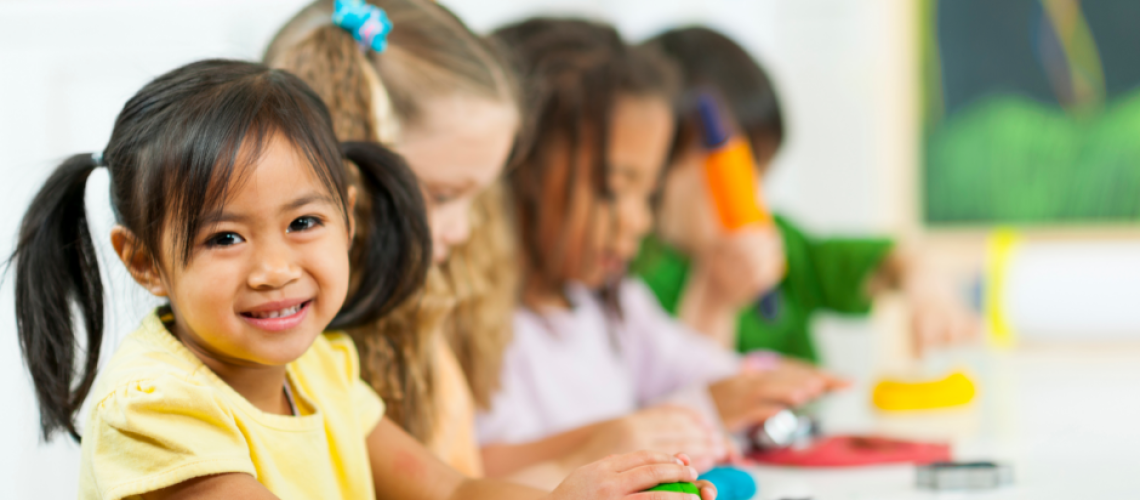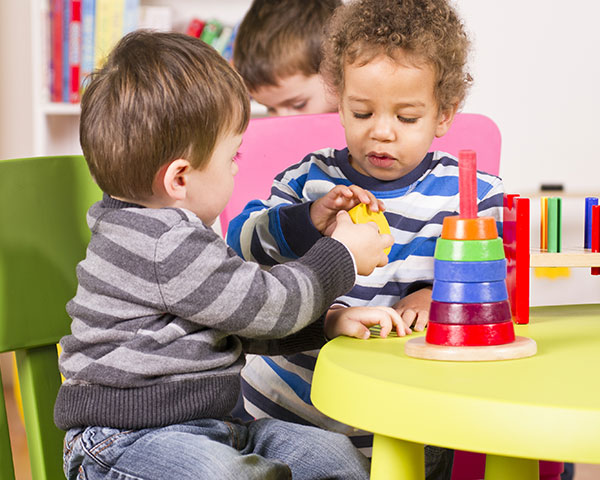September can feel like the start of a new year, a time of change. The temperature starts to cool, the leaves change colour and children return to school. It is a great time to refresh and reflect on ways to enhance and improve our child care programs. This includes reviewing practices and policies for overall health and well-being. Have you ever considered whether the learning environment where you work supports the health and well-being of the children and staff who spend time there? Do you wonder how to make your setting more environmentally sustainable?
To help answer these questions and more with current information and practical everyday ideas, the Canadian Partnership for Children’s Health and Environment (CPCHE) has created the Healthy and Sustainable Child Care Checklist and Resource Hub. For decades, CPCHE has worked to ensure that all children in Canada have healthy environments in which to live, learn, play and grow. One of CPCHE’s key initiatives is the annual Healthy Environments for Learning Day campaign. Healthy Environments for Learning Day (HELD), formerly known as Healthy Schools Day, aims to raise awareness of and encourage action to prevent environmental health risks to children in early learning environments and schools. This year the focus of HELD was on healthy and sustainable child care settings in Canada. A highlight of the 2022 HELD campaign was the launch of the CPCHE Healthy and Sustainable Child Care Checklist and Resource Hub, an updated and interactive online version of the popular CPCHE Child Care Checklist published in 2010.
What is the Healthy and Sustainable Child Care Checklist and Resource Hub?
The environments where children learn, play and grow influence their overall health and well-being and can affect a child’s health trajectory for life. From the types of toys, art supplies and cleaning products purchased, to policies on vehicle idling and nature-based play, everyday actions can create healthier and more sustainable learning environments. The Healthy and Sustainable Child Care Checklist and Resource Hub offers practical ideas and information for improved health and sustainability.
The ideas and suggestions included in CPCHE’s Checklist and Resource Hub can help a child care program go beyond basic regulatory requirements. Early Childhood Educators and providers can choose to use the checklist to learn about ways to enhance environmental health and sustainability in their program and to understand where there may be opportunities for improvement. Child care practitioners who complete the checklist will receive one hour of Professional Development credit from the Canadian Child Care Federation. Child care administrators and directors may choose to use this checklist with staff as an assessment and planning tool and a way to monitor progress over time. This information can be shared and celebrated with families, community and board members.
The checklist consists of 102 questions based on nine environmental health topic areas. The topic areas include:
- Air quality
- Outdoor learning and play
- Indoor learning and play
- Sun safety and extreme heat
- Cleaning and disinfecting
- Kitchen and food preparation
- Facility maintenance and office administration
- Sustainability and climate action
- Inclusivity, equity and accessibility
Aligned with these topic areas is a corresponding resource hub that explains why this topic is important from a health and environmental sustainability perspective, offers tips on everyday actions to create healthier and more sustainable child care programs, and provides links to relevant resources for those wishing to explore topics further.
Interested in finding out more about promoting healthy and sustainable child care environments? The CPCHE’s Child Care Checklist and Resource Hub is a great place to learn some basic ABCs to get started.
Air quality
Outdoor and indoor air quality can impact children’s health. Outdoors, air pollution from traffic, idling vehicles, gas stations, factories and other industrial facilities are sources of pollution that pose risks to children’s health. Indoors, mould, inadequate ventilation, and off-gassing from products and furnishings can contribute to poor air quality. Learn more about the importance of air quality and using the air quality health index.
Beat the heat
Outdoor activity is important for children’s physical fitness and lifelong health. Although sun exposure plays a vital role in getting adequate vitamin D, protecting children from overexposure to the sun and extreme heat is essential. With climate change, extreme heat events are becoming more frequent and more intense. Exposure to extreme heat, and heat-related illnesses are especially dangerous for infants and young children. Learn more about staying safe in the sun and dealing with extreme heat events.
Climate action
Climate change is causing severe and immediate risks and impacts in Canada and to communities around the world. Heat-related health impacts, deteriorating air quality, extreme weather events, eco-anxiety and food insecurity, have all been associated with climate change. Sustainable practices and climate actions in child care settings can help mitigate the impacts of climate change and model best practices for children and families. Find out what you can do, – every sustainable action helps!
Diverse and inclusive spaces
Children are likely to live and learn with people who may be very different from them. To prepare children for life in a diverse society, and to promote equity and inclusion, families and educators should encourage children’s positive feelings about themselves while fostering an understanding and acceptance of others. Taking actions to create welcoming, culturally engaging, safe spaces for all children is necessary to foster inclusive environments. Explore ways to create more inclusive spaces.
Everyday learning and play
Toys, arts and crafts materials and furnishings are a part of everyday indoor learning and play. To prevent exposures to toxic substances, attention should be given to what toys, craft materials and furnishings are made of, and whether they have been treated or coated with substances that may be harmful. Learn more about actions that can be taken to minimize exposure to toxic substances.
Food for thought
The food we eat and the water we drink nourish and replenish our bodies. Precautions should be taken to ensure that our food choices, as well as how we prepare and serve food minimize exposure to toxic chemicals. Care should also be taken to ensure drinking water is safe. Drinking water may contain lead which, even at low levels, can be harmful to children’s developing brains. Learn more about water, food prep and storage.
Going green while you clean
Infection prevention and control is essential in all settings, including environments where children spend time together. Young children transmit infections in any group setting by doing what comes naturally to them — sharing utensils, playing closely, holding hands, and sometimes forgetting to wash their hands. Cleaning practices should optimize health, minimize exposure to harmful chemicals while also being mindful of sustainability. Check out the latest on cleaning and disinfecting practices.
Healthy by nature
Spending time outdoors daily is an important part of school and child care programs and can contribute to improved physical and mental health, as well as foster children’s connection to place and values of stewardship. While spending time outside, it is important to take precautions to reduce toxic exposures, minimize insect bites and protect from sun exposure and UV. Learn more about staying healthy when outdoors.
In the office and around your facility
Another area to implement sustainable practices is with administrative and office tasks. This can include such measures as reducing unnecessary waste and reliance on resources such as paper. Regular equipment servicing and maintenance, as well as regular facility checks help to support a healthy environment for all children and staff. Renovations can be an opportunity to create healthier indoor environments by choosing safer materials and products and including energy efficient measures. Find out how to renovate right and include sustainable action in your administrative practices.
Check it out
This September, check out the Healthy and Sustainable Child Care Checklist and Resource Hub and find out everyday actions for healthy and sustainable child care environments. It is as simple as ABC!
Acknowledgements
The new Healthy and Sustainable Child Care Checklist and Resource Hub and the above post reflect the expertise and experience of many organizations and individuals, including Erica Phipps (CPCHE), Helen Doyle (CPCHE/Ontario Public Health Association – CPCHE partner organization), and Don Giesbrecht and Robin McMillan (CCCF – a CPCHE partner organization), among many others. Funding for the updating of CPCHE’s child care checklist and resource hub was provided by Health Canada and the Raffi Foundation for Child Honouring.
References:
Canadian Partnership for Children’s Health and Environment (2022). Creating Healthy and Sustainable Child Care Environments. (online resource hub and Checklist). https://healthyenvironmentforkids.ca/ child-care-resource/
Canadian Partnership for Children’s Health and Environment (2022). Healthy and sustainable child care environments: A vision for Canada. https://healthyschoolsday.ca/vision_child-care/
Canadian Partnership for Children’s Health and Environment. (2019). Position Statement on Climate Change. https://healthyschoolsdaycanada.files.wordpress.com/2019/11/cpche-statement-on-climate-change_en.pdf
Gillian Petrini bio:
Gillian Petrini is the Healthy Environments for Learning Day (HELD) Project Coordinator for the Canadian Partnership for Children’s Health and Environment. Gillian holds a BEd and MEd from the University of Victoria with a focus on environmental sciences. She has a passion for promoting healthy and sustainable environments and nurturing our relationship to the land and place. Her background includes over 15 years of working in both the early child care sector and K-12 education.












